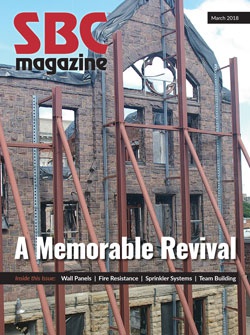Floor to Ceiling
Floor to Ceiling
“I was a framer who was getting wall panels I didn’t like and working with manufacturers I thought I could build better than. So I created a better system; I guess I’m a framer turned wall panel manufacturer.”
Bruce Jones, a turnkey contractor in Hanover, Pennsylvania, has been in the wall panel industry for over 30 years. He estimates that in 2017 his company built over 80 miles of walls. That experience has taught Bruce a number of ways to make a better panel.
First and foremost is accountability. As a turnkey contractor, Bruce’s crews not only manufacture wall panels, but also install them. From designers to wall production team members to installers, everyone Bruce hires is trained to be a worker who cares about the product and considers the next person who will touch it. “My guys want to be here,” Bruce says. They are part of the team, and the goal is to provide a great product that makes the life of the installer easier.
“We probably have four check-points before each panel gets out the door," Bruce adds, "in addition to self-audits and third-party review in the field.” That accountability leads to better quality, which is good because wall panel manufacturers are under pressure to build a better wall than competitors, particularly stick-framers, and build a wall framers want (and like) to install.
Chris Tatge, owner of Dynamic Construction in Stoughton, Wisconsin, has been a framer for nearly 20 years and has considered expanding the company to include wall panel manufacturing. Chris is determined to get the little things right.
“One thing I see are top plates lapped improperly at intersections. In that case, a framer has to get out their saw to cut the top plates or in some cases you have to get out the cat’s paw and take out up to 30 or 40 nails to readjust it,” Chris explains. “Taking the time to do that on a windy, winter day is not fun.”
Little things like that can have a big impact on whether an installer likes working with your products. Another example is improperly lapped sheathing. Chris says if sheathing runs long or is lapped incorrectly at joints, it falls on the framer to fix the problem.
“You’re dragging a saw into a place where it doesn’t need to be. You’re cutting through staples and nails for speed and you’re ruining your blade. By the time the sheathing is cut to the correct size, you stand that wall panel and it looks bad,” Chris said. “When framers run into this, it gets fixed in the fastest manner possible.”
Where wall panel technology goes next depends largely on panel manufacturers’ ability to produce a framer-friendly product as well as accommodate ever-evolving building codes. Annandale Millwork recognizes the increased requirements aiming at greater energy efficiency, and company president Gene Frogale wants to be ahead of the curve.
“We’re experimenting on the next generation of wall panels. We’ve done some research and development work on spray foam insulation so that we’re able to reach higher thermal performance,” Gene says. He predicts it’s only a matter of time before panel manufacturers “can go back to 2x4 studs, expand spacing to 24 inches on center, sheathe exterior walls with one inch of polyiso,” and maintain the same strength of a 2x6 wall with the added benefit of elevated thermal capacities.
“Value-added” is a buzzword throughout the building industry, and with wall panels, that has to be the sales pitch. Bruce agrees that shifting some parts of field installation to the manufacturing process pays dividends and sets one company apart from another.
“We’ve been installing hold-downs in our walls before sending them into the field bolted and customized,” he said. “It’s quicker in the shop and there’s fewer variables that might impact installation than in the field.”
Whether changes are brought about to make manufacturing and installation easier or in an attempt to please a client, moving forward is key for panel manufacturers. Gene says it best: “Analyzing and optimizing a component continues to be the art of being a good component manufacturer.”

